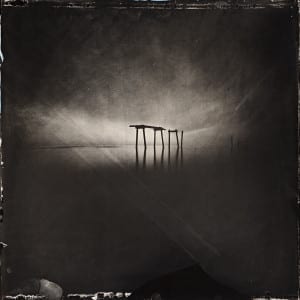
Don’t you sometimes just hate those triumphant, lyrical gallery statements about artists. The ones that have all that vocabulary stuff going on, quotes and hyperbolic imagery. Sometimes artwork demands it.
“There’s no need for anger
There’s no need for blame
There’s nothing to prove
Ev’rything’s still the same
Just a table standing empty
By the edge of the sea
Farewell Angelina
The sky is trembling
And I must leave” … from ‘Farewell Angelina’ by Bob Dylan
“Just a table standing empty by the edge of the sea,” Bob Dylan is an iconographer consistently distilling down images to words and music. It is not an easy thing to strike life into the quotidian, the mundane. Photographers S Gayle Stevens and Judy Sherrod have done it. Skeletons of ruined piers stand like Shinto Shrines in coal black planes of water. A beach at changing tide suggests something primordial beckoning to a guileless second line off in the distance; a cross rises amidst the march of buffeted stele. A monumental graphite platform dolefully awaits a deceased viking or a maritime native.
The images are wet plate collodion, tintypes, a painstaking process that requires the photographer to prepare the medium, expose it and develop it in situ. The plate must be fresh during the exposure. Judy met Gayle and proposed twenty inch by twenty inch plates to be shot with a pinhole camera that Judy would fabricate. Everyone said it couldn’t be done. The exposures were too long and the plates would dry out. Judy built the camera.
Ulysses S, Grant was seated in the photographer Mathew Brady’s studio in Washington D.C. when a workman fell through a skylight, startling the General and reportedly making a big impression on Brady. The great Warrior that had defeated the Confederacy and saved the Union appeared frightened and uneasy after the accident. Brady, aware of the power of the image, chose not to photograph Grant. He knew that the camera would capture the vulnerability and he would either be condemned as a fraud or a Southern sympathizer. Gayle, like Brady, has chosen wet plate collodion as her canvas. Gayle easily and gracefully exists within the constraints and starkness of this archetypal, photographic form — she also understands the power of the image.
Judy is a mathematician, a tinkerer; her mind constantly awash with possibilities. Gayle is an artist, walking around with beetle wings, squirrel teeth, and deceased honey bees in her pockets.
On the beaches of Pass Christian, Mississippi after the devastation of hurricane Katrina, together they became prestidigitators, conjurors. There is a sort of creative healing in the work. The pieces individually can be seen as totems to the power of wind and wave. As a body of work they are the imaginings of reluctantly grown children. Fishing piers stripped of their clothing become grand things. Rippled sand becomes lines of glistening licorice, confectioner’s script marching out to sea.
They chose to title the images “Nocturnes.” There is certainly something of Debussy and Chopin in the composition but there is nothing of the potentially malevolent dark night wandering their beaches. However, as the title implies — to walk among them can be a call to the night offices of a creative, aesthetic vigil.
All art is a feat of alchemy. The camera is mostly a realist as Mathew Brady knew. In certain hands it becomes a vehicle for turning lead into gold.
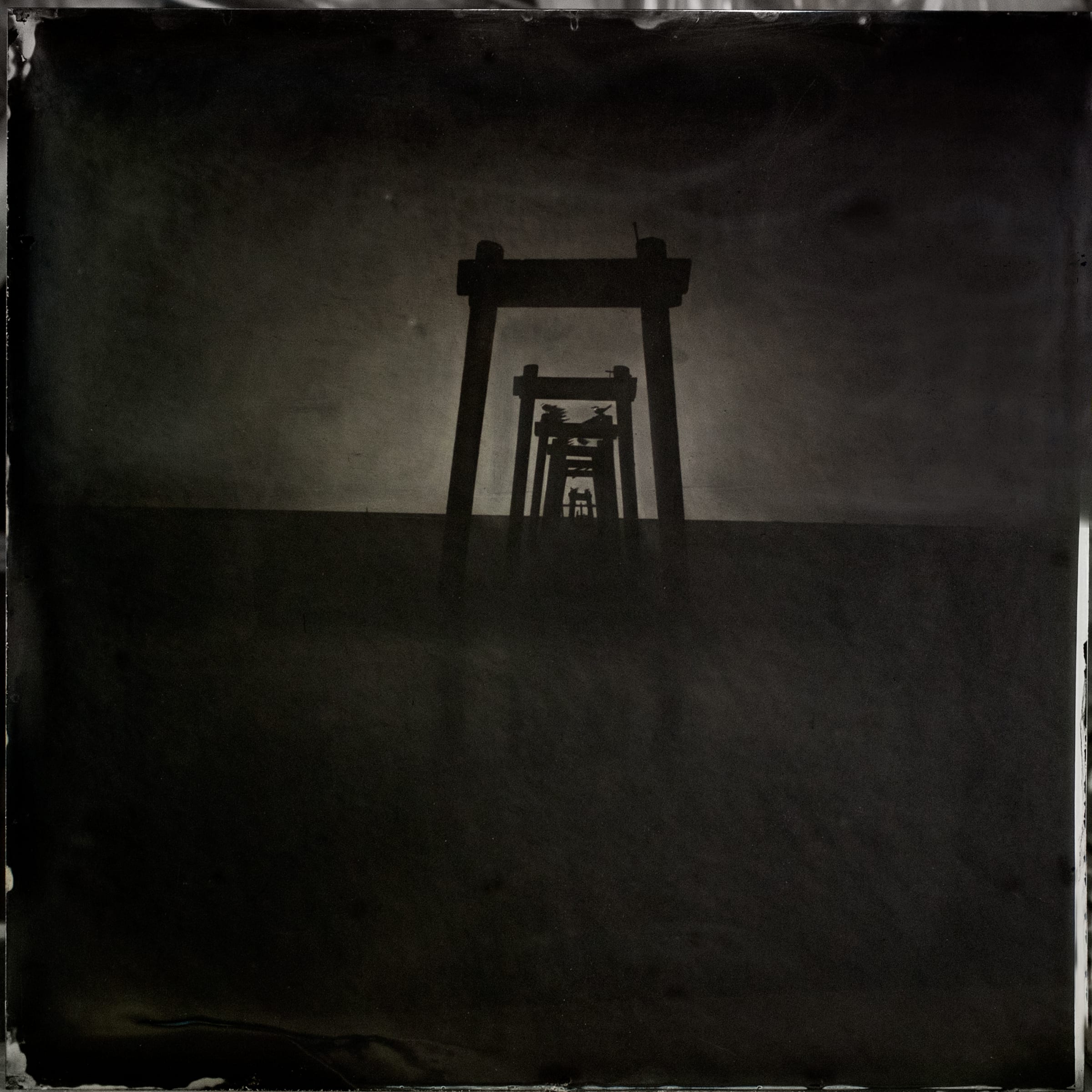
Kevin Tully is the Other Gallery Director at A Smith Gallery in Johnson City, Texas. The “Nocturnes” will be on display until the end of the year.
From the SxSE Archives, March 2012:
Collodion/Collaboration
Why would two women want to make 20-inch by 20-inch wet-plate collodion tintypes? Is size really that important to women? You betcha!
A conversation with S. Gayle Stevens and Judy Sherrod
Gayle: Hey, Judy, I don’t remember the exact impetus for creating mammoth plate pinhole tintypes, besides several glasses of Prosecco. I had been shooting small wet-plate pinhole tintypes for a while and you make really, really large pinhole cameras. Was it just the Prosecco that led us to create 20-inch by 20-inch wet-plate collodion pinhole tintypes?
Judy: Well of course, it was the Prosecco.
I’d been running up and down Route 66 in Oklahoma with a collection of 16 x 20 inch pinhole cameras in the back of the car with the puppy, shooting paper negatives as the end product. I didn’t know if it was possible to make tintypes with a big box. You mentioned that there was plenty of expert advice suggesting that wet-plate and pinhole photography simply couldn’t be combined. Slow plus slow equals too slow. I think that may be where the Prosecco came in. We could try. You are the collodion expert. I am the camera-maker. My task – to design a camera of dimension that maximizes the probability of your success.
Gayle: So, I guess that brings us to: why make a mammoth wet-plate collodion pinhole tintype because we can/did and no one (to my knowledge) else has? I got a lot of flack about wet-plate and pinhole, “why would you want to?”, “won’t work”, etc … But I love both. Why wouldn’t I want to merge my two loves? And, I hate to be told I cannot do something. So anyway, I digress (frequently). We two crazy old chicks decide we are amazing and invincible and we can do this.
Judy: I, like you, am highly motivated by the suggestion that something can’t be done. But let’s not forget about how much fun we have had in this collaborative work. You live in Chicago, I live in Texas, and we collaborate on the Mississippi Gulf coast. You do your creative work, I do mine, and then we get together and collaborate. That means talking, figuring things out, philosophizing, laughing, making even bigger plans for the next “project”, cooking (omg, can Gayle cook), drinking Prosecco, talking about Duchamp, Fluxus, The Starn Twins, William Kentridge, Jerry Saltz, and Damien Hirst’s “spots”. There are, of course, experts who suggest that artists can’t collaborate. Too much of that “temperamental artist” stuff. Well, we’ve been pretty loosey-goosey all along, and I would consider that a key to our success.
Shooting 1
Gayle: Back to SIZE… a 20-inch by 20-inch plate is HUGE and, frankly, intimidating. I knew they’d be large but I didn’t realize how large until I picked the plates up at the supplier. So everything in turn had to be larger in size or quantity. (I keep thinking of a scene from Young Frankenstein, I digress.) So I made a couple quart bottles of collodion, no problem, but the silver bath for sensitizing was. I don’t have a 20×20 silver bath for sensitizing mammoth plate, so we had to tray sensitize. With the price of silver extremely high, this was very costly. We had four and a half liters of silver which was barely enough to tray sensitize. It took a few tries pouring the plate to get it right. You had to pour it while I held the plate. Then trying to get this HUGE plate into the silver in one sweep, without stopping, with our 4.5 liters of silver was problematic. We really needed more silver, LOL. Tray developing and fixing were not an issue even at that size. On to shooting…
Judy: Yes, and I felt compelled, since I made the dang thing, to carry the camera from the car to the waterline and back. I have my daddy’s short legs, and it seemed as if the sand came up to my knees. So I did the toting the first time, and then you and your long legs took over. I say that particularly because it’s important that we learned along the way how to share the responsibilities – like you pointed out above, you held the plate with both hands and I poured the collodion. We didn’t think about that until first the collodion had gone all over the darkroom.
So, since we joked on the beach about “looking through the viewfinder”, why don’t you talk about the “pointing and shooting” part?
Shooting 2
Gayle: Yeah, that’s what we have – a 20×20 inch point-and-shoot camera, LOL, I love it! Since we are both pinhole shooters, we know to follow a diagonal line from the edge of the plate thru the pinhole – it gives you an idea of your image area, but it’s nice not to get too much info. I like some surprise. So since I became the packhorse I put the camera in the sand. Then we decided what we wanted to include and what should be the center of focus. There was very little banter since we have similar sensibilities about composition. Then it was just pinpointing the exposure.
Judy: Pinpointing! I get tickled when thinking about how we would move the camera an inch to the right or left, forward and backwards. Then, “Ok, now, are we going to shoot this scene on Manual or Programmed Automatic?” “Do you think we need to use the flash?” “How’s the depth of field looking?”
Gayle: The camera you built is 20-inches by 20-inches by 10-inches deep, so it’s extremely wide-angle and we’re losing a stop and a half at the corners. So I just calculated the exposure based on my previous wet-plate pinhole shots on the beach and Kentucky Windage, plus a little adjustment to enhance the vignetting and add a bit of drama…
Judy: And I was worried about the exposure… But you nailed it.
Gayle: Originally we were going to start this series in December, but the weather worked against us and we had to move it to January 2012. They have winter in Pass Christian, too. I shot a lot of my series, Pass, in January of 2010 and 2011. This place draws me in.
Judy: And I am fortunate to have a friend with a bungalow in Bay St. Louis, just across the bridge from Pass Christian. I’d never been to the area before going last August for a museum opening in New Orleans that featured Gayle’s piece, Pass. It works well. We collaborate, wine and dine ourselves, and then I go back to BSL so I can spend the evening making really lousy “night photography” images on 4×5-inch negatives. It works well.
Gayle: You know you’ve never actually shown me any of that work…
Judy Sherrod is a Texan. She is also: insightful, curious, supportive, grounded, creative, intelligent, and she pushes me out of my comfort zone and makes me a better artist. She is always with her dog B; they compliment each other. We are 366 days apart in age; I am the oldest. We don’t “gab”; we share ideas and we make them happen and Judy pushes me. Keep pushin’ me!
Judy: S. Gayle has both her BFA and MFA from the School of the Art Institute of Chicago. She teaches. Her students refer to her as “The Alt Queen”. She brings a lot to the table. I’ve always felt it important to study art outside the realm of your chosen genre. I have invested many semesters in Art History and in the study of modern and contemporary art. So Gayle and I can talk about Tim Hawkinson and Glenn Ligon and Sara Vanderbeek, and their work, etc. It’s important to do so. Those words of the conversation may not apply to this particular project, but they may very well come in handy on something else we are trying to accomplish. Or will in the future.
Now, with regard to this project, there is one thing about which I was absolutely certain: if something can be done in wet-plate collodion, S. Gayle Stevens can do it. I mean, if it is even remotely possible to make a wet-plate collodion image using a pinhole camera, then yes, she can make it happen. Even when the experts say, “you can’t”, I’m putting my money on Gayle.
It really is a synergistic working relationship. And we really do push each other.
Gayle: Cheers.
You may contact the collaborators via http://sgaylestevens.com and jfsherrod@aol.com
Nancy McCrary
Nancy is the Publisher and Founding Editor of South x Southeast photomagazine. She is also the Director of South x Southeast Workshops, and Director of South x Southeast Photogallery. She resides on her farm in Georgia with 4 hounds where she shoots only pictures.
1 Comment
Add comment Cancel reply
This site uses Akismet to reduce spam. Learn how your comment data is processed.


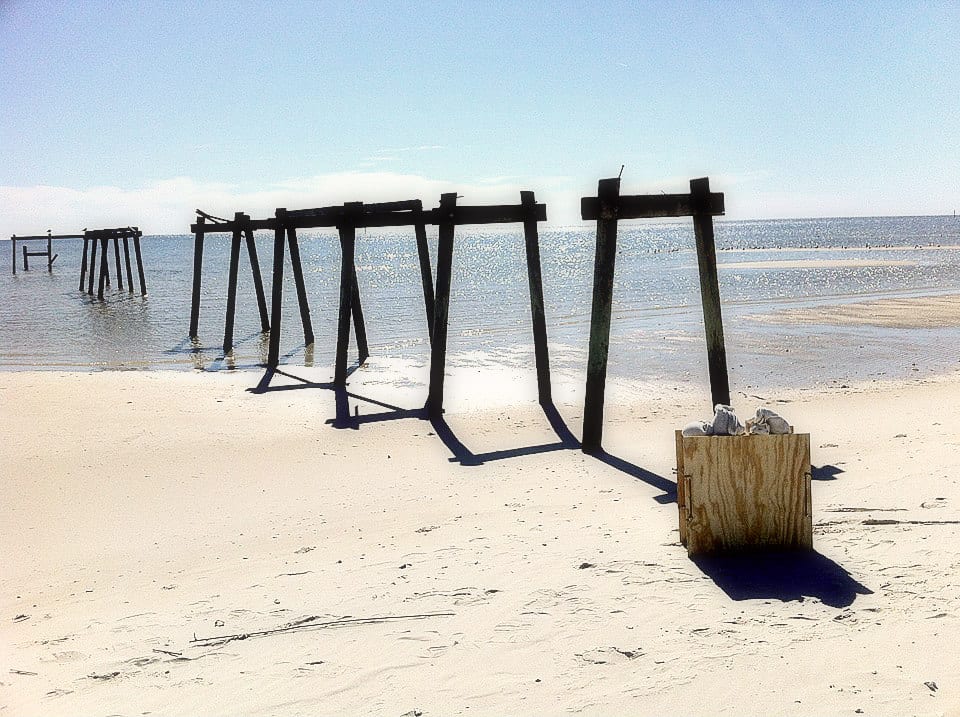
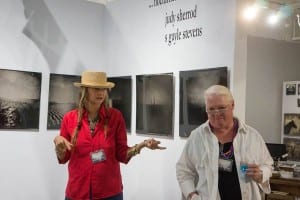
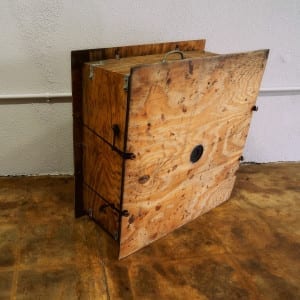
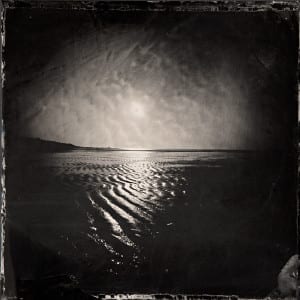
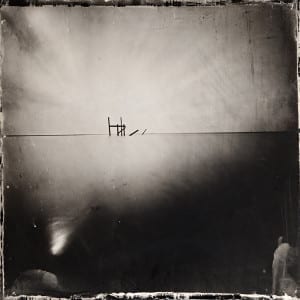
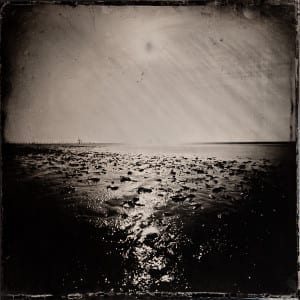
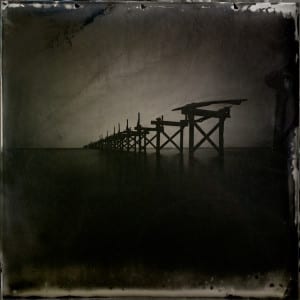
[…] may read it >>>> here […]